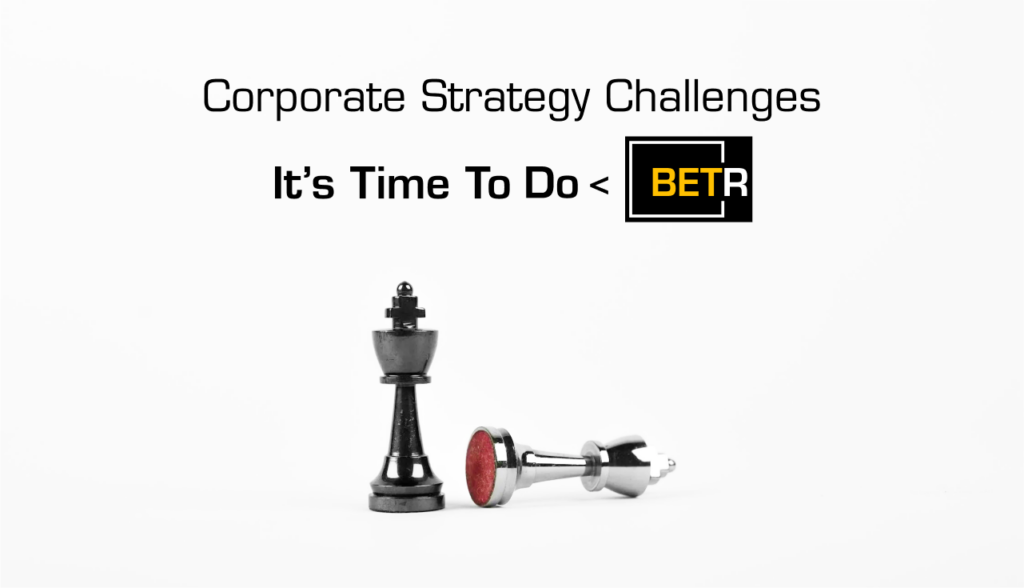CORPORATE STRATEGY CHALLENGES: IT’S TIME TO DO < BETR

In the late 1990s, Apple was floundering. Bloated with overlapping product lines, the company had lost its way. Then Steve Jobs returned. His first move? Slashing Apple’s sprawling portfolio from dozens of products to just four. Critics balked, but Jobs was unfazed. “Deciding what not to do is as important as deciding what to do,” he famously said.
That decision wasn’t just bold—it was transformative. With its newfound focus, Apple channeled all its resources into doing a few things better than anyone else. The result? A trillion-dollar company and a lesson for every business leader: more isn’t better—better is better.
The Problem: Strategy Without Restraint
Let’s get real: most corporate strategies today look nothing like Apple’s. Instead, they’re overstuffed with ambition:
● Objectives: “Double in size in 3 Years”, “Be the market leader,” “Innovate faster,” “Enter five new markets,” “Delight customers,” and “Reduce costs.”
● Initiatives: Dozens—sometimes hundreds—of projects that sound important but compete for the same scarce resources.
● Alignment: Everyone interprets the strategy differently, creating silos and internal competition.
The result? Chaos. Teams are stretched thin, priorities are muddled, and resources are wasted. Instead of driving results, companies are stuck spinning their wheels in a swamp of activity.
Here’s the uncomfortable truth: businesses fail not because they don’t work hard, but because they try to do too much with too little.
The Cost of Trying to Do It All
When companies try to pursue every opportunity, the costs are steep:
● Diluted Focus: Teams waste time on initiatives that don’t move the needle.
● Misaligned Resources: Departments fight over budgets, talent, and tools for projects that may not even matter.
● Execution Failure: No one has the bandwidth to do anything well, let alone everything. Even worse, this “do it all” mindset creates a culture of busyness over effectiveness. Everyone is working harder, but few are delivering meaningful results.
Do < BETR: The Antidote to Corporate Overload
Do < BETR is a simple yet radical idea: do fewer things, but do them better. At the corporate level, this means embracing focus, clarity, and ruthless prioritization. Here’s how to make it happen:
1. Cut the Bloat
Look at your current strategy. How many objectives and initiatives are on the table? Now ask yourself: if we could only focus on one or two, what would they be? That’s your real priority. Eliminate or delay everything else. Focus on the clear #1 Objective and at maximum the other 3-4 initiatives that support and align. Remember, Apple didn’t transform by tweaking—they cut. What are you willing to cut?
2. Align Resources with Strategy
Once you’ve identified your core focus, align every department around those Objectives. If an initiative doesn’t directly support the strategy, it doesn’t get resources—period. This isn’t about micromanaging; it’s about giving teams the clarity and freedom to excel where it matters most.
3. Build for Execution, Not Ambition
A great strategy on paper means nothing if it can’t be executed. Limit initiatives to what your team can realistically deliver with excellence. Ambition isn’t the problem—execution is. With success [as measured by Key Results], you can stretch your ambitions.
4. Measure What Matters
Instead of tracking dozens of metrics, focus on a handful of KPIs that directly reflect progress on your strategy. Keep it simple, visible, and actionable. The fewer metrics, the greater the clarity. Borrowing from John Doerr and the OKR framework, we have added an “I”. The “I” is for Initiatives that support the Objective and the measurable Key Results for OKRI’s.
Do Less. Achieve More.
Focusing on less isn’t easy. It requires discipline, tough conversations, and the courage to say “no.” But the payoff is immense:
● Teams thrive when they are not pulled in a dozen directions.
● Resources deliver more impact when they are concentrated on fewer initiatives.
● Strategies succeed when they are simple, clear, and actionable.
So, take a hard look at your strategy. How many initiatives could you cut? How many priorities are truly priorities? And what could your organization achieve if it focused on doing just a few things exceptionally well?
Do < BETR isn’t just a principle—it’s the path to winning. And like Apple, you don’t need to do it all to achieve greatness. You just need to do what matters, better than anyone else.
Next in the Series: Stay tuned for Part 2, where we’ll explore how Do < BETR applies to Sales Managers.

